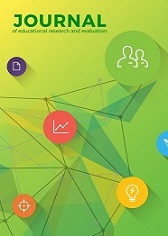Science Learning Achievement: Three Dimension-Media Innovation in Contextual Learning Approach
DOI:
https://doi.org/10.23887/jere.v3i4.22475Keywords:
contextual learning approach, three dimension media, learning achievementAbstract
Science learning achievement is low in some elementry schools in Bali and it is suspected that learning process is one of the factors that has caused this. Hence, there is a need for innovations in learning to improve learning process which has so far taken place (conventional). This study wasa aimed at finnding out the difference in science learning achievement between students who are taught through contextual learning which uses three dimension media and those who are taught through conventional learning..this is a quasi-experimental research with non equivalent post-test only control group design. The population used in this study was the fourth grade students af elementary schools in Gugus 1 Singaraja with the total number of eight schools. The sample in this study was selected using random sampling. Out of the eight schools in Gugus 1 Singaraja, two schools wereselected, namely SD No. 5 Banyuning as experiment group and SD No.6 Banyuning as conrol group.. the data gathered inthis study was in the form of science learning achievement. The instrument used to collect the data was an objective test or multiple choice. The data were analyzed using inferential statistics or t-test. The result showed that science learning achievement in the group where three dimension media were used had the mean score of 20.75 , which is higher than the group where conventional learning was used , whose mean score was 17. 08. This result was confirmed by hypothesis testing in which it was obtained that tobs. > tc.v.. This means that the implementation of contextual learning approach which was aided with three dimenisionmedia had a positive effect on science learning achivement.
References
Abimanyu, Soli, dkk. 2008. Strategi Pembelajaran. Ditjen Dikti Depdiknas. Jakarta.
Adhi. Made Kertha. 1996. Strategi Belajar Mengajar. Tabanan: Institut Keguruan dan Ilmu Pendidikan Saraswati.
Briggs, J.L. 1997. Instruction Design; Principle and Aplication. New York: Educational Technology Publication Inc.
Brooks, J.G. & Brooks, M.G. 1993. In Search of Understanding: The Case for Constructivist Classroom. Alexandria, VA: Assocation for Supervision and Curriculum Development.
Brown, Douglas H. 1973. Principles of Language Teaching and Learning. New Jersey: Prentice-Hall
Bundu, Patta. 2006. Penilaian Keterampilan Proses dan Sikap Ilmiah dalam Pembelajaran Sains di SD. Jakarta: Depdiknas.
Daryanto, 2012. Media Pembelajaran,Bandung:Sarana Tutorial Nurani Sejahtera,2012,hlmn.29
Djojosoediro, Wasih. (2010). Pengembangan dan Pembelajaran IPA SD. Bandung:Refika Aditama.
Duit. et. al. 1989. Teacher Use of Analogies in Their Regular Teaching Routines. Reasearch In Sciene Education. 19. 291-299.
Gardner, 1991. Fisiologi Tanaman Budidaya. UI Press: Jakarta
Handayani. 2009. Pendekatan Pembelajaran Kontekstua Sebagai Upaya Meningkatkan Kemampuan Menulis Deskripsi pada Siswa Kelas X SMA Negeri 2 Demak Tahun Ajaran 2008/2009. Surakarta: Fakultas Keguruan dan Ilmu Pendidikan Universitas Muhammadiyah.
Joyce, Bruce and Weil, Marsha. 1980. Models of Teaching (Second Edition). Englewood Cliffs, New Jersey: Prentice-Hall, Inc.
Nyoman Setiawan . 2012. Pengembangan Model Asesmen Autentik Pembelajaran IPA Kontekstual Terintegrasi Dengan Model Pengajaran Berpikir Tingkat Tinggi Sebagai Upaya Meningkatkan Kompetensi Siswa SMP. Jurnal Pendidikan Indonesia. Vol. 1, No. 1, April 2012. http://ejournal.undiksha.ac.id/index.php/JPI/article/view/4482/3455.
Puspaniati, N. K., Ni, P., Suarni, K., Widiana, I. W., Pd, S., Pd, M., Bk, J. (2014). Pengaruh Model Contextual Teaching and Learning Berbantuan Media Kit IPA Terhadap Hasil Belajar IPA Pada Siswa Kelas IV SD Sidetapa, (1).
Risnawati, Lina. 2012. “Pengaruh Latar Belakang Pendidikan dan Perhatian Orang Tua Terhadap Prestasi Belajar Siswa Kelas V SD Cakraningratan No.32 Tahun Ajaran 2011/2012”. Skripsi. Surkarta: UMS.
Sadia, I Wayan. 2008. Model Pembelajaran Yang Efektif Untuk Meningkatkan Keterampilan Berpikir Kritis Jurnal Pendidikan dan Pengajaran UNDIKSHA, No. 2 TH. XXXXI April 2008
Santyasa, I W. Model-Model Pembelajaaran Inovatif. Makalah Disajikan dalam pelatihan tentang Penelitian Tindakan Kelas bagi Guru-Guru SMP dan SMA di Nusa Penida ,tanggal 29 Juni s.d 1 Juli 2007
Savery, J.R., & Duffy, T.M. (1995). Problem-based learning: An instructional model and its constructivist framework. In B. Wilson (Ed.), Constructivist learning environments: Case studies in instructional design (pp. 135-148). Englewood Cliffs, NJ: Educational Technology Publications.
Septian, A., & Tampubolon, J. (2015). Pengaruh Pembelajaran Menggunakan Media Tiga Dimensi (3d) Terhadap Hasil Belajar Menggambar Dengan Perangkat Lunak Kelas Xi Program Keahlian Teknik Gambar Bangunan Smk Negeri 2 Meulaboh, 1, 70–78.
Suantini, Yuni., Jampel, & Widiana. 2013. Pengaruh Model Pembelajaran Kooperatif Tipe Circ Terhadap Pemahaman Konsep IPA Siswa Kelas IV Di Gugus II Kecamatan Gerokgak. Singaraja: Mimbar PGSD Undiksha.
Sukayanti. 2003. Pecahan. Yogyakarta: Departemen Pendidikan Nasional Dirjen Pendidikan Dsar dan Menengah. Pusat Pengembangan Penataran Guru (PPG) Matematika.
Suryasubrata, Soemadi. 1996. Psikologi Pendidikan. Bandung: Angkasa.
Tjokronegoro, A. 1999. Metodologi Penelitian Bidang Kedokteran. FKUI Jakarta
Trianto. 2010. Mendesain Model Pembelajaran Inovatif-Progresif. Jakarta: Kencana
Widiana. (2014). Pengaruh Model Contextu`al Teaching And Learning Berbantuan Media Kitipa Terhadap Hasil Belajar Ipa Pada Siswa Kelas IV Sd Sidetapa . Jurnal Mimbar PGSD Universitas Pendidikan Ganesha Jurusan PGSD (Vol: 2 No: 1 Tahun 2014) . http://ejournal.undiksha.ac.id/index.php/JJPGSD/article/viewFile/2228/1928
Downloads
How to Cite
Issue
Section
License
Authors who publish with the Journal of Evaluation and Research in Education (JERE) agree to the following terms:
- Authors retain copyright and grant the journal the right of first publication with the work simultaneously licensed under a Creative Commons Attribution License (CC BY-SA 4.0) that allows others to share the work with an acknowledgment of the work's authorship and initial publication in this journal.
- Authors are able to enter into separate, additional contractual arrangements for the non-exclusive distribution of the journal's published version of the work (e.g., post it to an institutional repository or publish it in a book), with an acknowledgment of its initial publication in this journal.
- Authors are permitted and encouraged to post their work online (e.g., in institutional repositories or on their website) prior to and during the submission process, as it can lead to productive exchanges, as well as earlier and greater citation of published work. (See The Effect of Open Access)











